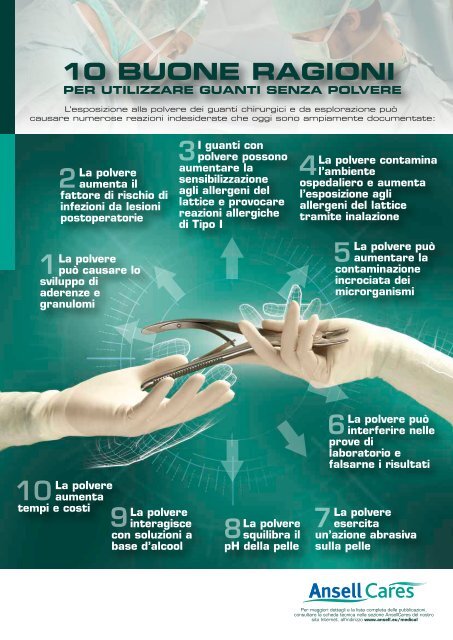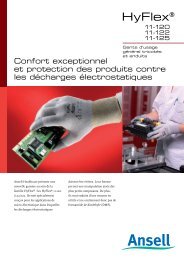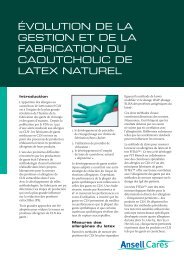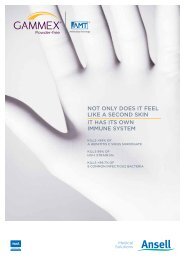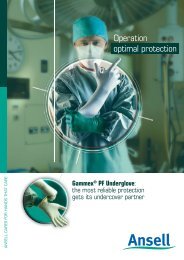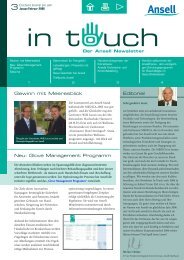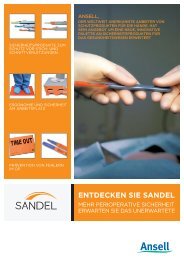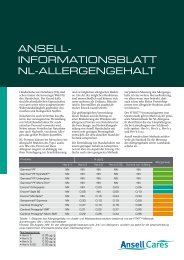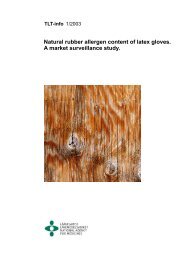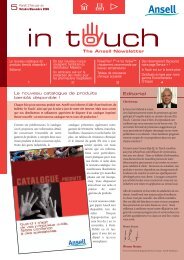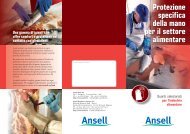10 BUONE RAGIONI - Ansell Healthcare Europe
10 BUONE RAGIONI - Ansell Healthcare Europe
10 BUONE RAGIONI - Ansell Healthcare Europe
Create successful ePaper yourself
Turn your PDF publications into a flip-book with our unique Google optimized e-Paper software.
<strong>10</strong> <strong>BUONE</strong> <strong>RAGIONI</strong><br />
PER UTILIZZARE GUANTI SENZA POLVERE<br />
L’esposizione alla polvere dei guanti chirurgici e da esplorazione può<br />
causare numerose reazioni indesiderate che oggi sono ampiamente documentate:<br />
1<br />
<strong>10</strong><br />
2<br />
La polvere<br />
aumenta il<br />
fattore di rischio di<br />
infezioni da lesioni<br />
postoperatorie<br />
La polvere<br />
può causare lo<br />
sviluppo di<br />
aderenze e<br />
granulomi<br />
3<br />
La polvere<br />
aumenta<br />
tempi e costi La polvere<br />
9 interagisce<br />
con soluzioni a<br />
base d’alcool<br />
I guanti con<br />
polvere possono<br />
aumentare la<br />
sensibilizzazione<br />
agli allergeni del<br />
lattice e provocare<br />
reazioni allergiche<br />
di Tipo I<br />
8<br />
La polvere<br />
squilibra il<br />
pH della pelle<br />
4<br />
La polvere contamina<br />
l’ambiente<br />
ospedaliero e aumenta<br />
l’esposizione agli<br />
allergeni del lattice<br />
tramite inalazione<br />
7<br />
5<br />
La polvere può<br />
aumentare la<br />
contaminazione<br />
incrociata dei<br />
microrganismi<br />
6<br />
La polvere può<br />
interferire nelle<br />
prove di<br />
laboratorio e<br />
falsarne i risultati<br />
La polvere<br />
esercita<br />
un’azione abrasiva<br />
sulla pelle<br />
Per maggiori dettagli e la lista completa delle pubblicazioni,<br />
consultare la scheda tecnica nella sezione <strong>Ansell</strong>Cares del nostro<br />
sito Internet, all'indirizzo www.ansell.eu/medical
<strong>10</strong> <strong>BUONE</strong> <strong>RAGIONI</strong> PER UTILIZZARE<br />
GUANTI SENZA POLVERE<br />
L’esposizione alla polvere dei guanti chirurgici e da esplorazione<br />
può causare numerose reazioni indesiderate che oggi sono ampiamente documentate:<br />
1. LA POLVERE PUÒ CAUSARE LO SVILUPPO DI ADERENZE E GRANULOMI.<br />
Dimostrata per la cavità peritoneale; documentata in quasi tutti i siti anatomici come occhi, regione orale, cavità cranica,<br />
orecchio medio, torace, vescica. 1,2,3,4,5,6,7,8,9,<strong>10</strong>,11,12,13,14,15,16<br />
2. LA POLVERE AUMENTA IL FATTORE DI RISCHIO DI INFEZIONI DA LESIONI POSTOPERATORIE.<br />
Come per la maggior parte dei corpi estranei, la polvere del guanto riduce l’inoculo di batteri necessario per portare alla<br />
formazione di ascessi (in questo caso il fattore di riduzione è di almeno <strong>10</strong> volte 15 ). Inoltre, la polvere ritarda la<br />
guarigione delle lesioni e altera il normale processo di riparazione, aumentando al contempo la reazione infiammatoria<br />
delle lesioni stesse. 16,17,8<br />
3. I GUANTI CON POLVERE POSSONO AUMENTARE LA SENSIBILIZZAZIONE AGLI ALLERGENI DEL<br />
LATTICE E PROVOCARE REAZIONI ALLERGICHE DI TIPO I.<br />
I guanti con polvere possono presentare livelli nettamente superiori di allergeni del lattice di gomma naturale rispetto ai<br />
guanti senza polvere. Possono quindi aumentare la sensibilizzazione al lattice e indurre una reazione immediata di<br />
ipersensibilizzazione di Tipo I tramite contatto diretto. 18,19,20,21,22,23,24,25,26,27,28,29,30<br />
4. LA POLVERE CONTAMINA L’AMBIENTE OSPEDALIERO E AUMENTA L’ESPOSIZIONE AGLI ALLER-<br />
GENI DEL LATTICE TRAMITE INALAZIONE.<br />
La polvere si può legare agli antigeni delle proteine dell’NRL (lattice di gomma naturale). Queste particelle di polvere<br />
rivestite di allergeni/proteine possono liberarsi nell’aria quando i guanti vengono calzati o sfilati. L’eventuale inalazione o<br />
ingestione di tali particelle può causare sensibilizzazione e varie reazioni allergiche all lattice di gomma naturale (ad es.<br />
sintomi alle vie aeree superiori o irritazioni agli occhi). 31,32,33,34,35,36<br />
5. LA POLVERE PUÒ AUMENTARE LA CONTAMINAZIONE INCROCIATA DEI MICRORGANISMI.<br />
La polvere del guanto può anche fungere da veicolo per microrganismi opportunisti e patogeni, aumentando il rischio<br />
professionale per operatori della sanità e pazienti. È stata inoltre ampiamente documentata una contaminazione da<br />
particelle di polvere anche su cateteri, reni perfusi per trapianto e materiale per cosmesi dentale (corone, protesi). 37,38<br />
6. LA POLVERE PUÒ INTERFERIRE NELLE PROVE DI LABORATORIO E FALSARNE I RISULTATI.<br />
La polvere può falsare i risultati come il valore PCR (Reazione a catena della polimerasi), l’immunodosaggio enzimatico,<br />
alcuni test HIV; può inoltre far diagnosticare per errore un carcinoma metastatico anziché un granuloma da polvere.<br />
39,40,41<br />
7. LA POLVERE ESERCITA UN’AZIONE ABRASIVA SULLA PELLE.<br />
La polvere ha un effetto meccanico sulla pelle della mano aumentandone la rugosità, come evidenziato dall’analisi profilometrica<br />
nella riproduzione della cute delle mani. 42<br />
8. LA POLVERE SQUILIBRA IL PH DELLA PELLE.<br />
Il normale pH della pelle di protezione contro i microrganismi (batteri, funghi) è di 5.5. A causa dell’alcalinità della<br />
polvere, il pH della pelle resta alcalino per ore dopo aver indossato guanti con polvere. 42,43,44<br />
9. LA POLVERE INTERAGISCE CON SOLUZIONI A BASE D’ALCOOL.<br />
Dopo aver tolto i guanti, i detergenti a base d’alcool possono interagire con la polvere residua presente sulle mani del<br />
personale, dando una sensazione ruvida al tatto. La polvere tende anche a sporcare le mani con un contenuto organico<br />
che deve essere eliminato con acqua e sapone prima di applicare nuovamente detergenti a base d'alcool. 45,46<br />
<strong>10</strong>. LA POLVERE AUMENTA TEMPI E COSTI.<br />
Ad ogni modo, la polvere deve essere eliminata dopo aver calzato un guanto chirurgico (usando acqua salina o sterile e<br />
salviette o spugne sterili), con conseguente aggiunta di tempo e costi all’intervento chirurgico. È stato documentato<br />
come almeno sette volte più costoso dell’utilizzo di guanti senza polvere e al tempo stesso inefficace nell’eliminare<br />
totalmente la polvere del guanto. 47,48
BIBLIOGRAFIA:<br />
(1) Lyon F, Taylor RH: Conjunctival granuloma caused by surgical talc. J AAPOS. 2007 Aug;11(4):402-3. Epub 2007 Apr 19.<br />
(2) Dwivedi AJ, Kuwajerwala NK, Silva YJ, Tennenberg SD. Effects of surgical gloves on postoperative peritoneal adhesions and cytokine expression in a rat model.<br />
Am J Surg. 2004 Nov;188 (5):491-4.<br />
(3) Van den Tol MP, Haverlag R, van Rossen ME, Bonthuis F, Marquet RL, Jeekel J. Glove powder promotes adhesion formation and facilitates tumour cell adhesion<br />
and growth Br J Surg. 2001 Sept; 88 (9):1258-63<br />
(4) Luijendijk RW, cdLange DCD, Wauters CCAP, Hop WCJ, Duron JJ, Pailler JL, Camprodon BR, Holmdahl L, vanGeldorp HJ, Jeekel J. Foreign material in<br />
postoperative adhesions. Annals of Surg, 223: 242-248, 1996.<br />
(5) Becker JM, Dayton MT, Fazio VW, et al. Prevention of postoperative abdominal adhesions by a sodium hyaluronate based bioresorbable membrane: a<br />
prospective randomized double blind multicenter study. J Am Coll Surg, 1996 183: 297-306.<br />
(6) Hunt TK. Can adhesions be prevented? J Amer Coll Surgeons, 183: 406-407, 1996.<br />
(7) Duron, J.J. et al. Post-operative peritoneal adhesions and foreign bodies. Eur. J. Surg. Suppl. 1997; vol. 579: 15-16.<br />
(8) Cantoni GM, Longo T. [Peritoneal reactions caused by starch used regularly for lubricating surgical gloves. Review of the literature] Minerva Chir. 1994 Jun;<br />
49(6):569-74.<br />
(9) Kamffer WJ, Jooste EV, Nel JT, de Wet JI. Surgical glove powder and intraperitoneal adhesion formation. An appeal for the use of powder-free surgical gloves.<br />
S Afr Med J. 1992 Feb 1;81(3):158-9.<br />
(<strong>10</strong>) Hunt, T.K. et al. Starch powder contamination of surgical wounds. Arch. Surg. 1994; vol 129(8): 825-827.<br />
(11) Eynon CA, Thomson WH: Experimental study of starch-induced intraperitoneal adhesions. Br J Surg. 1991 Mar; 78(3):377.<br />
(12) McEntee GP, Stuart RC, Byrne PJ, Leen E, Hennessy TP. Experimental study of starch-induced intraperitoneal adhesions. Br J Surg, 77: 113-114, 1990.<br />
(13) Eggert A, Teichmann W, Dociu N, Kopf R. [Starch granulomas caused by glove powder] Chirurg. 1981 Jun; 52(6):380-4. Yaffe H et al. Potentially deleterious<br />
effect of cornstarch glove powder in tubal reconstruction surgery. Fertil Steril 1978; 29(6):699–701.<br />
(14) Yaffe H et al. Potentially deleterious effect of cornstarch glove powder in tubal reconstruction surgery. Fertil Steril 1978; 29(6):699–701.<br />
(15) Emerson, M. Chairman’s conclusions. Eur J Surg. 1997.<br />
(16) Odum, B.C. et al. Influence of absorbable dusting powders on wound infection. J. Emerg. Med. 1998; vol. 16(6): 875-9.<br />
(17) Filon F., Larese Radman G. Latex Allergy: A Follow-up Study of <strong>10</strong>40 <strong>Healthcare</strong> workers. Occupationnal and Environmental Medecine 2006 Feb; 63(2):121-5.<br />
(18) Bousquet J, Flahault A, Vandenplas O, et al. (2006). Natural rubber latex allergy among health care workers: a systematic review of the evidence. J Allerg<br />
Clin Immunol 118: 447-454.<br />
(19) Allmers H, Schmengler J, John SM. 2004 Decreasing incidence of occupational contact urticaria caused by natural rubber latex allergy in German healthcare<br />
workers. J Allergy Clin Immunol 114:347-351.<br />
(20) Reunal T., Turjanmaa K., Alenius H., Reinikka-Railo H., Palosuo T. A Significant Decrease in the incidence of Latex-Allergic <strong>Healthcare</strong> Workers Parallels with a<br />
Decreasing Percentage of Highly Allergenic Latex Gloves in the Market in Finland. J.Allergy Clin. Immunol. 2004; 113(2): S60, Abstract 140.<br />
(21) Cullinan P, Brown R, Field A, et al. 2003 Latex allergy. A position paper of the British Society of Allergy and Clinical Immunology. Clin Exp Allergy 33:<br />
1484-1499.<br />
(22) Kelly KJ., Klancnik M., Kurup V, Barrios-Jankol C., Fink J.N. and Petsonk E.L. A Four-Year Prospective Study to Evaluate the Efficacy of Glove Interventions in<br />
Preventing Natural Latex Sensitization in <strong>Healthcare</strong> Workers at Two Hospitals. J. Allergy Clin. Immunol. 2003, Part 2; Vol. 111, No. 2, No. 426.<br />
(23) Charous BL, Blanco C, Tarlo S, Hamilton RG, Bayr X, Beezhold D, Sussman G, Yuninger JW. Natural Rubber Latex Allergy after 12 Years: Recommendations<br />
and Perspectives. J Allergy Clin Immunol. 2002 Jan;<strong>10</strong>9 (1):31-4.<br />
(24) Hunt, L. W., Kalker P., Reed, C.E. and Yunginger J. W. "Management of Occupational Allergy to Natural Rubber Latex in a Medical Center: The Importance of<br />
Quantitative Latex Allergen Measurement and Objective Follow-Up.J. Allergy Clin. Immunol. 2002; 1<strong>10</strong>:S94-<strong>10</strong>6.<br />
(25) Turjanmaa K., Kanto M., Kautiainen H., Reunala T. and Palosuo T. Long-term Outcome of 160 Adult Patients with Natural Rubber Latex Allergy. J. Allergy Clin.<br />
Immunol. 2002; 1<strong>10</strong>: S70-74.<br />
(26) Edelstam G, Arvanius L, Karlsson G. Glove Powder in the Hospital Environment–Consequences for<strong>Healthcare</strong> Workers. Intl. Arch Occup Environ Health. 2002<br />
Apr;75(4):267-7<br />
(27) Cuming R. Reducing the Hazard of Exposure to Cornstarch Glove Powder. AORN. 2002 Aug;76(2):288-95.<br />
(28) Tarlo S.M., Easty A., Dubanks K., Min F. and Liss G.Outcomes of a Natural Rubber Latex Control Program in an Ontario Teaching Hospital. University Health<br />
Network and Department of Medicine and Public Health Sciences, University of Toronto. J. Allergy Clin. Immunol. 2001; <strong>10</strong>8: 628-633.<br />
(29) Phillips ML, Meagher CC, Johnson DL. What is “Powder-free”? Characterisation of Powder Aerosol Produced during Simulated Use of Powdered and<br />
Powder-free Latex Gloves. Occup Environ Med.2001 Jul;58(7):479-81.<br />
(30) Liss GM, Tarlo SM. Natural Rubber Latex-related Occupational Asthma: Association with Interventions and Glove Changes over Time. Am J Ind Med. 2001<br />
Oct;40(4):347-53.<br />
(31) Dyck R. Historical Development of Latex Allergy. AORN. 2000 July.<br />
(32) Allmers H, Brehler R, Chen Z, Raulf-Heimsoth M, Fels H, Bayr X. Reduction of Latex Aeroallergens and Latex specific IgE Antibodies in Sensitised Workers<br />
After Removal of Powdered Natural RubberLatex Gloves in a Hospital. J Allerg Clin Immunol. 1998 Nov;<strong>10</strong>2(5): 841-6<br />
(33) Hesse A, Peters KP, Koch HU. Type I Allergies to Latex and the Aeroallergenic Problem. Euro J Surg Supp. 1997;579:19-22<br />
(34) Newsom SW, Shaw M. A Survey of Starch Particle Counts in the Hospital Environment in Relation to the Use of Powdered Latex Gloves. Occup Med (London).<br />
1997 Apr;47(3):155-8<br />
(35) Tomazic JV et al. Cornstarch powder on latex products is an allergen carrier. J Clin Immunol 1994; 93(4): 751–8.<br />
(36) Moriber-Katz, S. et al. Contamination of perfused donor kidneys by starch from surgical gloves. Am J Clin Pathol.1998; Jul90 (1): 81-84.<br />
(37) Min KW et al. Cornstarch embolization in renal transplants. Kidney Int 1972; 2: 291–2.<br />
(38) Lampe AS et al. Wearing gloves as cause of false negative HIV tests. Lancet 1998; 2(8620): 1140–41.<br />
(39) Lomas JG et al. False negative results by polymerase chain reaction due to contamination by glove powder. Transfusion 1992; 32: 83–5.<br />
(40) Sharefkin JB et al. The cytotoxic effect of surgical glove powder particles on adult human vascular endothelial cell cultures:implications for clinical users of<br />
tissue culture techniques. J Surg Res 1986; 41: 463–72.<br />
(41) Brehler R, Voss W, Müller S. Glove powder affects skin roughness, one parameter of skin irritation. Contact Dermatitis. 1998 Nov;39(5):227-30.<br />
(42) Mirza R, Maani N, Liu C, Kim J, Rehmus W.A randomized, controlled, double-blind study of the effect of wearing coated pH 5.5 latex gloves compared with<br />
standard powder-free latex gloves on skin pH, transepidermal water loss and skin irritation. Contact Dermatitis 2006 Jul;55(1):20-5.<br />
(43) Brehler R, Rütter A, Kütting B.Allergenicity of natural rubber latex gloves.Contact Dermatitis. 2002 Feb; 46(2):65-71<br />
(44) Pittet D, Allegranzi B, Boyce J; World Health Organization World Alliance for Patient Safety First Global Patient Safety Challenge Core Group of Experts.The<br />
World Health Organization Guidelines on Hand Hygiene in Health Care and their consensus recommendation. Infect Control Hosp Epidemiol. 2009 Jul;30(7):611-<br />
22.<br />
(45) Boyce JM, Pittet D; <strong>Healthcare</strong> Infection Control Practices Advisory Committee. Society for <strong>Healthcare</strong> Epidemiology of America. Association for Professionals<br />
in Infection Control. Infectious Diseases Society of America. Hand Hygiene Task Force. Guideline for Hand Hygiene in Health-Care Settings: recommendations of the<br />
<strong>Healthcare</strong> Infection Control Practices Advisory Committee and the HICPAC/SHEA/APIC/IDSA Hand Hygiene Task Force. Infect Control Hosp Epidemiol. 2002<br />
Dec;23(12 Suppl):S3-40.<br />
(46) Phillips, V.L., et al. Health Care Worker Disability Due to Latex Allergy and Asthma: A Cost Analysis. American Journal of Public Health 1999 89(7),<br />
<strong>10</strong>24-<strong>10</strong>28.<br />
(47) Field, E.A. The use of powdered gloves in dental practice: a cause for concern? J. Dent. 1997; vol. 25: 209-214.


